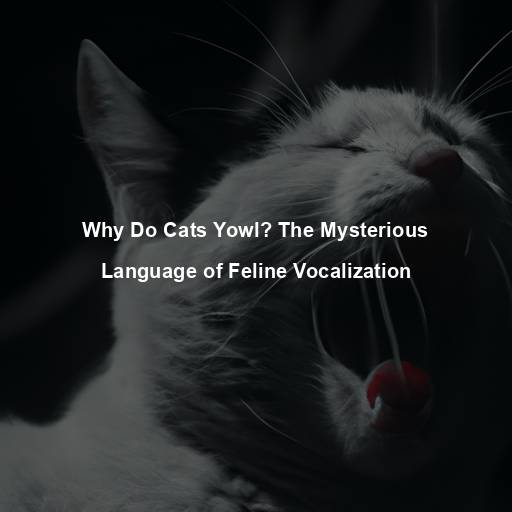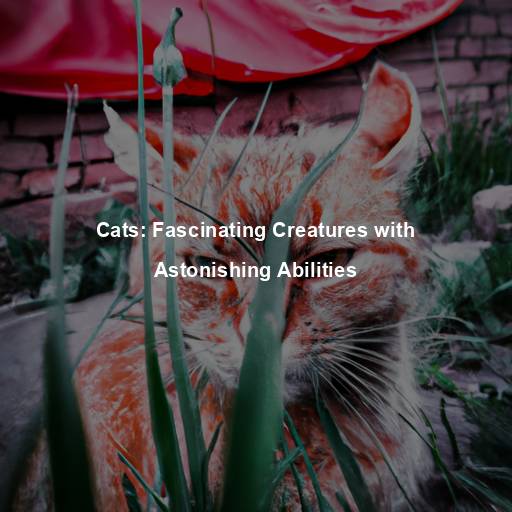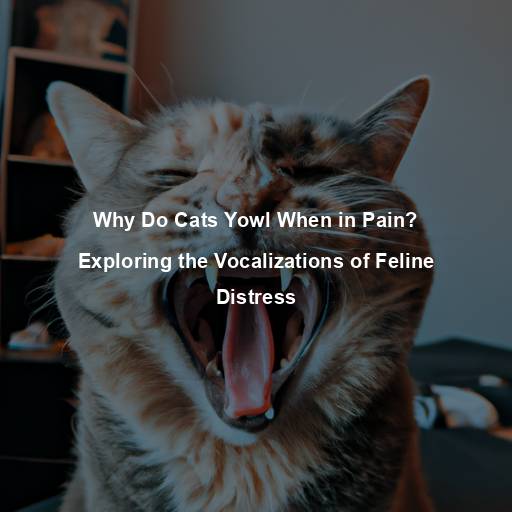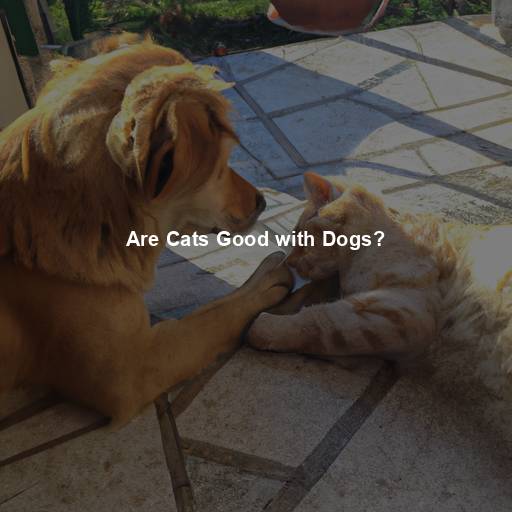Why Do Cats Yowl? The Mysterious Language of Feline Vocalization
Last Updated on July 21, 2023 by Evan
Contents [hide]
- 1 Understanding the Language of Cats
- 1.1 Unraveling the Mystery of Yowling
- 1.2 Addressing the Root Causes of Yowling
- 1.3 The Language of Yowls: Listening to Our Cats
- 1.4 Meows: The Versatile Vocalization
- 1.5 Purr: The Comforting Vibration
- 1.6 Chirps, Trills, and Chirrups: The Playful Exchanges
- 1.7 Growls, Hisses, and Snarls: The Defensive Vocalizations
- 1.8 The Art of Cat Communication: Observing Body Language
- 1.9 Deepening the Bond: Listening and Responding to Our Cats
- 2 FAQs for Why Do Cats Yowl
- 2.1 What is yowling in cats?
- 2.2 Why do cats yowl during the night?
- 2.3 What are some other reasons why cats yowl?
- 2.4 Can yowling be a sign of illness?
- 2.5 How can I stop my cat from yowling?
- 2.6 Are there any behavioral techniques to reduce yowling?
- 2.7 Should I be concerned if my cat occasionally yowls?
Understanding the Language of Cats
Cats have long captivated our hearts with their enigmatic behaviors and mysterious vocalizations. One such vocalization that often leaves us puzzled is the yowl. As cat owners, we may find ourselves wondering, “Why do cats yowl”? In this article, we will delve into the fascinating world of feline vocalization, exploring the reasons behind this particular sound and deciphering the messages cats convey through their yowls.
Unraveling the Mystery of Yowling
Have you ever heard that eerie sound piercing through the quiet night? The yowling, with its elongated, resonating melody, can’t help but captivate our attention. It’s a mystical symphony of emotions, ranging from a mournful lament to an urgent plea, echoing through the depths of our souls. Yet, behind this enigmatic vocalization lies a hidden language, speaking volumes about the desires and needs of our beloved feline companions.
Hunger and Thirst
If you’ve ever wondered why your feline friend suddenly turns into a vocal diva, the answer may lie in their desire to satisfy their rumbling tummy or quench their parched throat. Yes, dear reader, the enigmatic yowls that reverberate through your home could be a simple plea for sustenance. These meows, accompanied by restless pacing, affectionate rubs against their food bowls, or even attempts to guide you towards their next meal, speak volumes about their hunger and thirst. It’s as if they’re trying to convey their needs to you in their own mysterious language.
Attention-Seeking Behavior
While cats are often celebrated for their independent demeanor, it’s a lesser-known fact that they actually yearn for social connection and seek affection from their human counterparts. In moments of neglect or a longing for companionship, they express their desires through yowling – an intriguing vocal tactic aimed at capturing our undivided attention. This peculiar behavior typically manifests when we become absorbed in activities that unintentionally distract us from our feline companions, leaving them puzzled and desperate for some much-needed interaction.
Territorial Disputes
In the intricate world of feline behavior, cats have a natural penchant for asserting their territorial dominance, often resorting to the art of yowling. This distinct vocalization serves as a powerful proclamation of ownership, triggered by the mere presence of unfamiliar feline trespassers or other intruding creatures within their coveted domain. Not to be underestimated, this territorial display is often accompanied by a grand performance of hissing, growling, as well as the strategic release of territorial markers such as urine or claw marks. It seems that even amidst the complexity of cat communication, their innate territorial nature remains ever fascinating and enigmatic.
Stress and Anxiety
Yowling can also be an expression of stress and anxiety in cats. Significant life changes, such as moving to a new home, the arrival of a new pet or baby, or even changes in their daily routine, can trigger feelings of unease in our feline companions. Yowling in these situations may serve as a release valve for their pent-up emotions and a way to communicate their distress.
Addressing the Root Causes of Yowling
In deciphering the enigmatic language of a cat’s yowling, we uncover a labyrinth of hidden motivations that call for our attention. Only by untangling the intricate web of these mystifying sounds can we hope to restore serenity within the walls of our abode. With keen observation and insightful deduction, we can unravel the cryptic puzzle and guide our feline friends back to tranquility.
Meeting Basic Needs
When it comes to deciphering the mysterious yowls of our feline friends, the answer might lie in their basic needs – hunger and thirst. One way to alleviate their persistent vocalizations is to ensure that their food and water bowls are consistently topped up. Establishing a structured feeding routine and providing a generous supply of fresh water can work wonders in appeasing their cravings. For an added dash of mental stimulation, consider introducing interactive feeding toys or puzzle feeders to keep their curious minds engaged and their meows at bay.
Providing Enrichment and Attention
Creating a harmonious environment for your feline friend can be a perplexing task. To counter the bursts of attention-seeking yowling, it’s essential to engage in regular playtime sessions. Catering to their primal instincts through interactive toys and scratching posts will keep their mental and physical state in balance. Additionally, nurturing a strong emotional bond with your cat through quality time and affection will ensure a harmonious coexistence.
Creating a Safe and Secure Environment
When dealing with territorial disputes, it is essential to create a safe and secure environment for your cat. Provide multiple litter boxes and ensure they are clean and easily accessible. Create vertical spaces such as cat trees or shelves to allow your cat to observe their surroundings and establish a sense of control. Additionally, consider using pheromone sprays or diffusers to create a calming atmosphere within your home.
Reducing Stress and Anxiety
If your cat’s yowling is a result of stress or anxiety, provide them with a quiet and secluded space where they can retreat and feel secure. Consider using pheromone products, such as Feliway, which mimic the natural calming pheromones produced by cats. These products can help reduce anxiety and promote a sense of relaxation. In severe cases, consult with your veterinarian, who may recommend behavior modification techniques or even prescribe medication if necessary.
The Language of Yowls: Listening to Our Cats
While understanding the reasons behind a cat’s yowling is essential, it is equally important to listen to the unique vocalizations of our feline companions. Each cat has its own distinct vocal repertoire, and attentive observation can help decipher their individual language. By paying attention to the context, accompanying body language, and the nuances of their yowls, we can establish a deeper connection and respond more effectively to their needs.
In conclusion, the enigma of why cats yowl can be unraveled by understanding the multiple purposes this vocalization serves. From expressing hunger and seeking attention to defending their territory and communicating stress, our feline friends use yowling as a powerful tool to convey a range of emotions. By addressing their underlying needs, providing enrichment, and creating a harmonious environment, we can foster a stronger bond with our cats and ensure their well-being and happiness. So, the next time you hear your furry friend yowl, pause, listen, and respond with love and understanding.
Cats, those enigmatic creatures of the feline world, possess a wide array of vocalizations that baffle and intrigue us. From the gentle purr that signifies contentment to the sharp hiss that warns of danger, each meow and yowl serves a distinct purpose in their complex communication repertoire. By unraveling the mystery of these vocal cues, we can unlock a deeper understanding of our feline companions, unveiling their hidden emotions and fulfilling their mysterious needs.
Meows: The Versatile Vocalization
The world of feline vocalizations encompasses a plethora of intriguing sounds. Among these, the enigmatic meow reigns supreme in its ubiquity and distinctiveness. Yet, let us unravel the intricacies and demarcations within this sonorous realm, for not all meows are created equal. Embracing brevity and gentleness, the meow serves as a multifaceted medium of interaction between our beloved feline friends and their human counterparts.
The Greeting Meow
Have you ever wondered what goes on in your furry feline friend’s mind when they greet you with a crisp and cordial meow? It’s their intriguing way of conveying a warm hello and acknowledging your existence. The harmony of their gentle tail wag and a relaxed body posture completes this enigmatic yet heartwarming gesture.
The Demanding Meow
When your adorable feline companion begins to serenade you with an unrelenting chorus of meows, it’s no ordinary symphony. This persistent and unwavering meow, filled with an air of urgency and insistence, can only mean one thing – they have a demand that must be met. Whether it’s attention, a scrumptious meal, or the desire to explore an off-limits zone, their expressive vocals will stop at nothing until their desires are fulfilled. So, if you find yourself amidst this feline opera, be prepared to decipher their perplexing requests and act swiftly, for their meows grow louder and more impassioned with each passing moment.
The Contented Meow
When your feline companion emits a soft, gentle, and melodic meow, it is a delightful indication of their profound contentment and utmost satisfaction. This melodious sound, reminiscent of a gentle lullaby, serves as a testament to their relaxed disposition, supreme comfort, and sheer enjoyment of your company.
Purr: The Comforting Vibration
Another fascinating vocalization in a cat’s repertoire is the purr. Unlike meows and yowls, purring is a unique vocalization produced through the rapid vibration of the cat’s larynx and diaphragm. While purring is often associated with contentment, it can also signify a range of other emotions:
Contentment and Relaxation
The most common interpretation of purring is that of contentment and relaxation. When your cat purrs while curled up in your lap or during a gentle stroking session, they are expressing their comfort and trust in you.
Healing and Self-Soothing
Did you know that when cats purr, it’s more than just a way of communicating with us? It’s actually a fascinating mechanism that helps them calm down and even heal themselves. Whether they’re injured, stressed, or in pain, purring acts as a natural self-soothing technique that brings comfort and promotes healing. This seemingly simple act of feline communication is truly a wonder of nature.
Solicitation for Care
Cats have an enigmatic way of seeking attention – one perplexing move they make is purring. It’s their feline strategy to capture your sympathy and convey their various needs. Whether it’s for a cozy cuddle, a bountiful bowl of food, or some energetic playtime, their burst of purrs will surely leave you wondering what they truly desire.
Chirps, Trills, and Chirrups: The Playful Exchanges
The feline world is brimming with an extraordinary symphony of melodic expressions that never fails to captivate our hearts. Cats, in their enigmatic ways, unleash a vast repertoire of delightful vocalizations, ranging from the subtlest chirps to the most exuberant trills and chirrups. These enchanting sounds, harmoniously intertwined with mesmerizing tail flicks and playful gestures, create a captivating dance of communication, forging stronger bonds between these majestic creatures and their human companions or fellow feline beings alike.
When our furry friends are in their hunting mode, something fascinating happens – they burst forth with vocalizations that leave us both perplexed and intrigued. As they stalk their toys or imagine themselves on a thrilling prey chase, their communication style takes on a whole new level of excitement. These playful sounds serve as signals, broadcasting their anticipation and intention to dive headfirst into their favorite pastime.
Growls, Hisses, and Snarls: The Defensive Vocalizations
As our exploration of feline vocalizations continues, we cannot ignore the intriguing defensive side of cat communication. Amidst the harmonious and melodic tunes we’ve discussed before, it is crucial to shed light on the bursts of growls, hisses, and snarls that cats unleash when faced with threats or fear. These perplexing vocalizations act as a formidable deterrent, springing forth as cautionary signals for any potential aggressor.
Growls
When feline fury ignites, it unleashes a symphony of growls, resonating deep within the very core of their being. These guttural vocalizations serve as an unwavering declaration, a fierce proclamation of their indomitable will to protect their precious realm. As the air crackles with tension, their bodies become a masterpiece of contradiction – a graceful arching of their back juxtaposed with the instinctive baring of teeth and sharpened claws, creating an enigmatic and perplexing sight to behold.
Hisses
Hisses are sharp and forceful sounds that cats make by forcefully expelling air through their mouths. Hissing is a clear sign of agitation and is intended to intimidate potential threats. Cats may hiss when confronted with unfamiliar animals or when they feel cornered.
Snarls
When it comes to the art of communication in the animal kingdom, snarls take the crown. With a blend of growls and hisses, these rugged vocalizations are like a thunderstorm of warning signals. Emerging from moments of heated clashes and territorial tug-of-wars, snarls cut through the air, leaving no doubt that it’s time to retreat and reconsider one’s choices.
The Art of Cat Communication: Observing Body Language
While vocalizations are an essential aspect of feline communication, it is equally crucial to pay attention to a cat’s body language to gain a comprehensive understanding of their emotions and intentions. Here are some key body language cues to consider:
Tail Positions
Have you ever found yourself gazing into the enigmatic world of a cat’s tail, desperately trying to decipher their complex emotions? Well, let me shed some light on this feline mystery for you. It turns out that these mesmerizing appendages can reveal a multitude of feelings – from tranquility to trepidation. A calm and fluid sway of the tail can be a telltale sign of blissful contentment, while a rigid and fluffed-up tail can be an ominous signal of fear or aggression.
Ear Positions
The position of a cat’s ears can convey their mood effectively. Forward-facing ears indicate attentiveness and interest, while flattened ears against the head signal fear or aggression. Slightly twitching ears may indicate curiosity or anticipation.
Eye Expressions
Cats communicate through their eyes, and their expressions can reveal a wealth of information. Dilated pupils often indicate excitement, fear, or arousal, while constricted pupils may suggest aggression or stress. A slow blink from a cat is a sign of trust and affection.
Body Posture
Observing a cat’s distinctive body language can unlock an enigmatic realm of feline emotions. When their body assumes a relaxed and uninhibited posture, it signifies a serene state of comfort and bliss. Conversely, a cat’s tense and hunched form unveils a clandestine fear or an instinctive preparation for self-defense. Be wary of the mystifying sight of an arched back and an erect tail, for it may camouflage an undercurrent of aggression lurking within.
Deepening the Bond: Listening and Responding to Our Cats
Understanding the intricate language of cats requires careful observation, active listening, and a willingness to respond appropriately to their needs. By paying attention to their vocalizations, body language, and individual preferences, we can forge stronger bonds with our feline companions and create environments that cater to their well-being.
Remember, every cat is unique, and their communication styles may vary. Spend quality time with your cat, engage in interactive play, and provide them with a safe and enriching environment. By doing so, you will not only deepen your understanding of their vocalizations but also strengthen the unbreakable bond between you and your beloved feline friend.
Exploring the enigmatic world of cats, we unveil the fascinating tapestry of their vocalizations. In the intricate symphony of meows, purrs, chirps, and growls, lies a lexicon of emotions and intentions waiting to be deciphered. By immersing ourselves in the captivating realm of feline communication, attuning our senses to their vocal cues and subtle body language, we unlock the gates to a deeper level of understanding and connection with our mysterious companions. With open hearts and eagerness, we embark on a transformative odyssey of love, companionship, and the perplexing language of our feline friends.
FAQs for Why Do Cats Yowl
What is yowling in cats?
Yowling in cats refers to a loud and intense vocalization that they make. It is a long and drawn-out sound that can sometimes resemble a combination of meowing, howling, and crying. Cats use yowling as a way to communicate their emotions, needs, or to express discomfort or distress.
Why do cats yowl during the night?
Have you ever wondered why those furry felines go into yowling mode when twilight hits? Brace yourself for a whirlwind of reasons! It turns out that cats are masters of seeking attention, particularly when they find themselves stuck in a boredom or loneliness loop. As nocturnal creatures, they embrace the night like a siren’s call, using their vocal cords to serenade their owners into granting them playtime or simply keeping them company. And hold on tight because the plot thickens! Older cats, amidst the perplexities of cognitive or sensory changes that come with age, might just add an extra layer of burstiness to their midnight symphony.
What are some other reasons why cats yowl?
Cats, those enigmatic creatures of the feline world, have quite the repertoire when it comes to expressing their needs and emotions. While some may see their yowling as a mere cry for attention, these vocalizations can actually convey a myriad of messages. Picture this: a cat, with a rumbling tummy and a disrupted feeding schedule, unleashing a symphony of yowls that could rival an opera performance. Or consider the female cat in heat, captivating potential mates with her enchanting yowls that seem to whisper secrets into the night. Yet, yowling isn’t just a stage for attention-grabbing antics. It can also be a distress signal, a cry for help from a cat in pain or discomfort, a flare thrown in the face of potential health issues. To truly unravel the enigma of a cat’s yowling, one must carefully observe the context and frequency of these vocal outbursts. Only then can we confidently decipher the perplexing language of our feline friends.
Can yowling be a sign of illness?
Yes, yowling can be a sign that something is wrong with your cat’s health. If your cat suddenly starts yowling excessively or in a different tone than usual, it is advisable to consult a veterinarian. In some cases, yowling can indicate pain, discomfort, or underlying medical conditions such as urinary tract infections, hyperthyroidism, or arthritis. Seeking veterinary advice will help identify and address any potential health issues.
How can I stop my cat from yowling?
Understanding the root cause of your cat’s relentless yowling is pivotal in finding a solution that will bring peace to your household. Consider their cry for attention – are they longing for mental and physical stimulation? Engaging them in interactive play sessions, and offering an array of tantalizing toys can work wonders. However, if their yowling persists, it’s imperative to seek prompt veterinary care as it could be a giveaway sign of an underlying health issue. Furthermore, neutering or spaying your feline friend can significantly diminish their noisy amorous pursuits. Establishing a consistent feeding schedule and addressing any potential health concerns will also go a long way in curbing their perplexing outbursts.
Are there any behavioral techniques to reduce yowling?
If you’re tired of your feline companion’s serenades that rival an opera singer, fear not! There are a few tricks up your sleeve to quell the yowling mayhem. One approach is positive reinforcement training, where you reward your cat when they opt for silence over decibels. Additionally, creating a serene and secure environment for your furry friend, complete with a cozy bed or secret hideout, can help alleviate any anxiety-induced vocalizations. With a little patience and some clever tactics, you can tango with tranquility instead of turbulent yowls.
Should I be concerned if my cat occasionally yowls?
Occasional yowling is typically not a cause for concern, especially if your cat appears happy and healthy otherwise. Cats, like humans, may have occasional moments when they express themselves more vocally. However, if the yowling becomes excessive, changes in tone or frequency, or if it is accompanied by other abnormal behavior or physical symptoms, consulting a veterinarian is recommended to ensure there are no underlying health issues contributing to the yowling.






